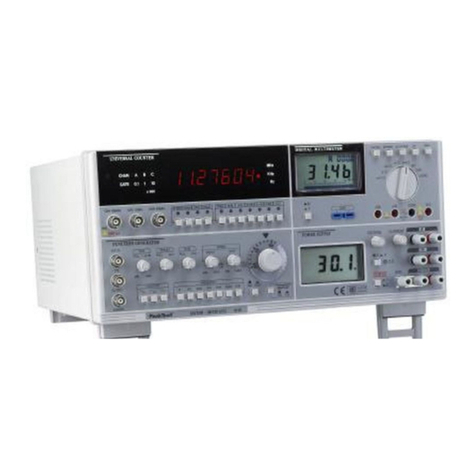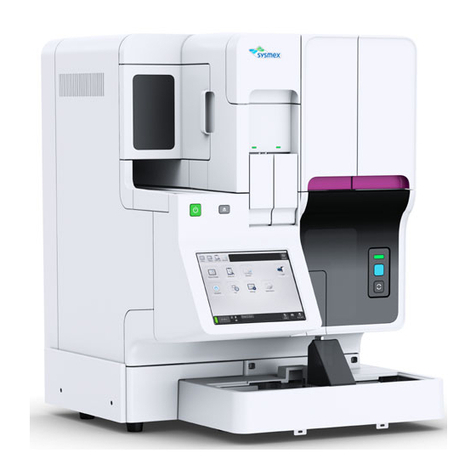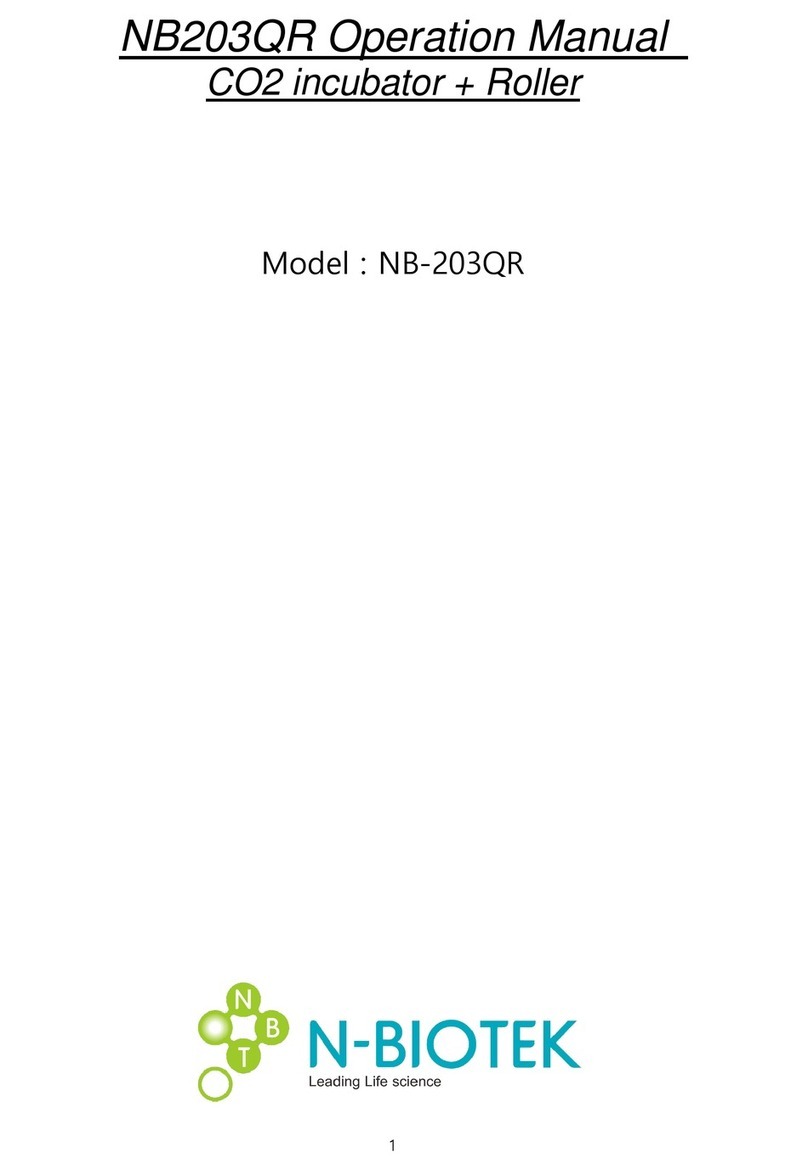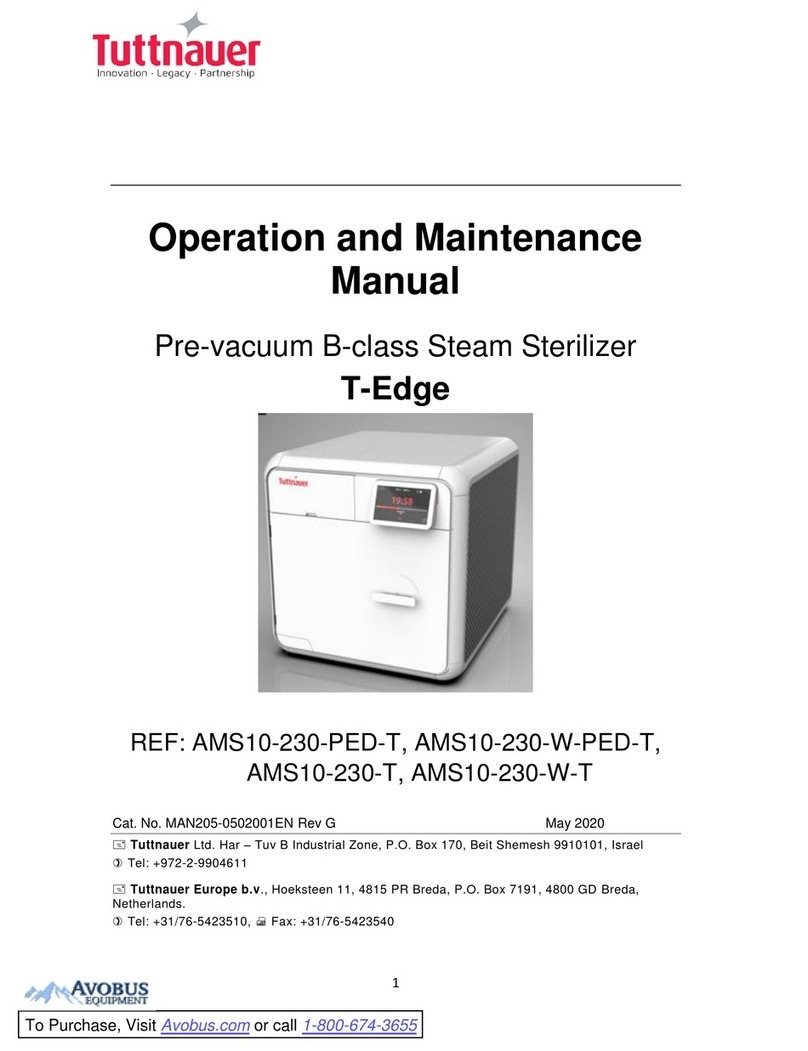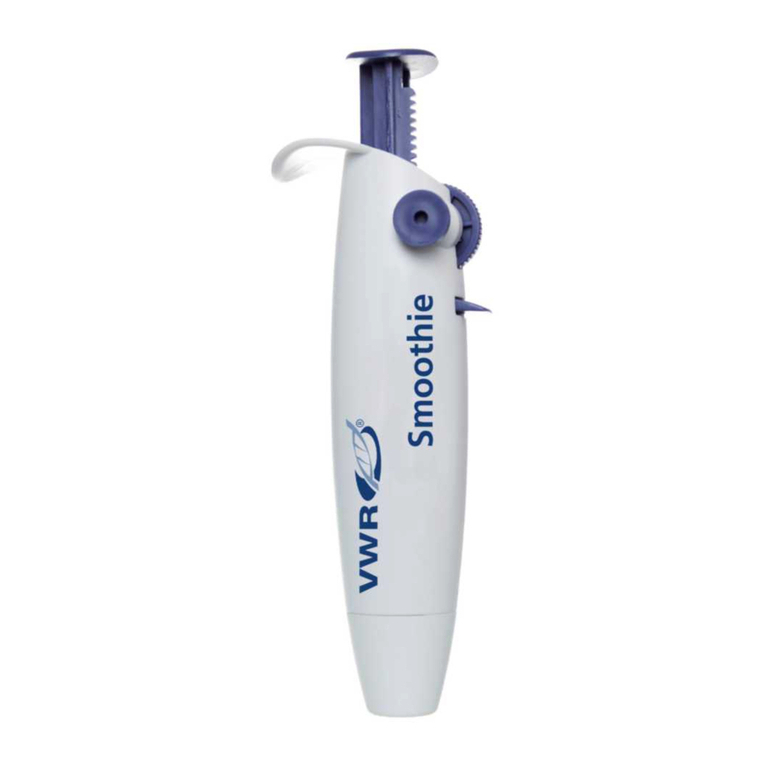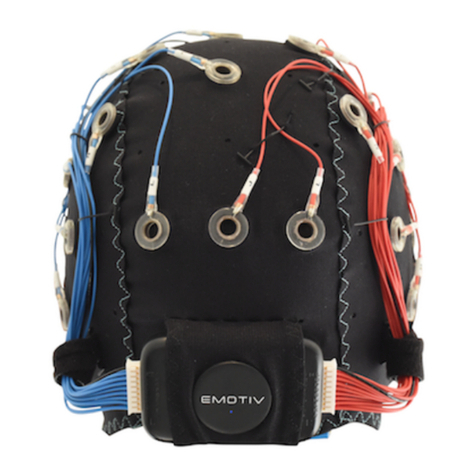SIGRIST VisGuard 2 Extractive User manual

Document number: 14265E
Version: 1
Valid from: S/N 704010 /
SW V529
INSTRUCTION MANUAL
VisGuard 2 Extractive
Sampling System
Visibility Monitor / Dust Monitor

Copyright© SIGRIST-PHOTOMETER AG, subject to technical changes without notice 4/2018
SIGRIST-PHOTOMETER AG
Hofurlistrasse 1
CH-6373 Ennetbürgen
Switzerland
Tel. +41 41 624 54 54
Fax +41 41 624 54 55
inf o@photometer.com
w w w .photometer.com

Contents Instruction Manual VisGuard 2 Extractive
14265E/1 3
Contents
1General user information........................................................................................5
1.1 Terms used in this document (glossary) ........................................................5
1.2 Purpose of the Instruction Manual ...............................................................5
1.3 Target group of the documentation .............................................................5
1.4 Additional documentation ..........................................................................5
1.5 Copyright provisions ..................................................................................5
1.6 Document storage location .........................................................................6
1.7 Order document ........................................................................................6
1.8 Proper use ................................................................................................6
1.9 User requirements .....................................................................................6
1.10 Declaration of conformity ...........................................................................6
1.11 Use restrictions ..........................................................................................6
1.12 Dangers when not used properly .................................................................7
1.13 Meaning of the safety symbols....................................................................7
1.14 Meaning of the pictograms.........................................................................8
2Sampling systems ..................................................................................................9
2.1 Different versions.......................................................................................9
2.2 Designation of the components...................................................................9
2.3 Technical data .........................................................................................10
2.3.1 Technical data for the fan KTNPI/G1......................................................10
2.3.2 Technical data for the fan KZTN2..........................................................10
2.3.3 Technical data for the valve unit ST2MP3...............................................11
2.3.4 Technical data for the sample heater KW5.............................................11
3General safety points ...........................................................................................12
3.1 Dangers when properly used.....................................................................12
3.2 Residual risk............................................................................................13
3.3 Warning and danger symbols on the instrument .........................................13
3.4 Preventing undesirable online access attempts ............................................14
4Design and function ............................................................................................15
4.1 Design of the sampling system..................................................................15
4.2 Functional description of the most important elements ................................16
4.2.1 Valve unit for multiple sampling ...........................................................16
4.2.2 Sample divider for single sampling ........................................................17
4.2.3 Flow rate monitoring ...........................................................................17
4.2.4 Suction fan.........................................................................................18
5Mounting ...........................................................................................................19
5.1 Sampling point ........................................................................................19
5.2 Sample transport .....................................................................................19
5.2.1 General information ............................................................................19
5.2.2 Dimensioning of the lines ....................................................................19
5.2.3 Selecting and laying the lines ...............................................................20
5.3 Additional components ............................................................................20
5.3.1 Connection for external instruments (KZTN9) .........................................20
5.3.2 Valve unit (ST2MP3) ............................................................................20
5.3.3 Back pressure nozzle KZTN6 and pressure monitor KZTN7 .......................21
5.3.4 Sample divider KTNPI2.........................................................................22
5.3.5 Sample heater KW5 ............................................................................23
5.3.6 Filter KZTN3 .......................................................................................23
5.3.7 Suction fan KTNPI/G1 or KZTN2 with motor circuit breaker MSS1 .............23
5.3.8 Purging air connection and flow divider KZTN2.1....................................24
5.4 Sample return .........................................................................................24

Instruction Manual VisGuard 2 Extractive Contents
4 14265E/1
6Electrical installation ............................................................................................25
6.1 Safety pointers for the electrical connection................................................25
7Commissioning ...................................................................................................26
8Servicing.............................................................................................................27
8.1 Servicing schedule ...................................................................................27
8.2 Checking for leaks ...................................................................................28
8.3 Checking the sampling points ...................................................................28
8.4 Replacing the suction fan filter cartridge KZTN3 ..........................................29
8.5 Cleaning the sample lines .........................................................................29
8.6 Replacing the purge air filter on the VisGuard 2 Extractive ............................30
9Troubleshooting on additional components ............................................................31
9.1 General troubleshooting...........................................................................31
9.2 Malfunctions on the sample heater KW5....................................................32
9.3 Malfunctions on the valve unit ST2MP3......................................................32
9.4 Malfunctions on the suction fan ................................................................33
10 Repair work ........................................................................................................34
10.1 Replacing the sample heater KW5 .............................................................34
10.2 Replacing the valve unit ST2MP3 ...............................................................35
10.3 Replacing the suction fan .........................................................................36
11 Customer service information ...............................................................................37
12 Decommissioning/Storage ....................................................................................38
12.1 Decommissioning the system ....................................................................38
12.2 Storing the components ...........................................................................38
13 Packaging/Transport/Returning .............................................................................39
14 Disposal .............................................................................................................40
15 Spare parts list ....................................................................................................41
16 Appendix............................................................................................................42
17 Index..................................................................................................................44
Makr o
Makr o

General user information Instruction Manual VisGuard 2 Extractive
14265E/1 5
1General user information
1.1 Terms used in this document (glossary)
Please refer to our website for specialist terms: www.photometer.com/en/glossary/
1.2 Purpose of the Instruction Manual
This Instruction Manual provides the user with helpful information about the entire life cycle
of the VisGuard 2 Extractive and its peripheral devices. Before commissioning the instrument,
you should be completely familiar with the Instruction Manual.
1.3 Target group of the documentation
This Instruction Manual describes the dimensioning, installation and operation of the Vis-
Guard 2 Extractive sampling system, which is used for the continuous measurement of dust
in gases at temperatures of up to 40 °C (maximum temperature for the fan). It is intended
for planners and installers who are responsible for the installation and operation of the me a-
suring instrument. This document supplements the existing Instruction Manual for the Vis-
Guard 2 and may only be used in combination with this manual.
1.4 Additional documentation
DOC. NO.
TITLE
CONTENT
14162E
Instruction Manual
Contains the most important information about the
overall life cycle of the instrument.
14165E
Reference Manual
More sophisticated menu functions and worksteps
for advanced users.
14166E
Brief Instructions
The most important functions and the servicing
schedule.
14289E
Data Sheet
Descriptions and technical data about the instru-
ment.
14168E
Service Manual
Repair and conversion instructions for service engi-
neers.
14288DEF
Declaration of Con-
formity
Compliance with the underlying directives and
standards.
1.5 Copyright provisions
This document has been written by SIGRIST-PHOTOMETER AG. Copying or modifying the
content or giving this document to third parties is permitted only with the express consent of
SIGRIST-PHOTOMETER AG.

Instruction Manual VisGuard 2 Extractive General user information
6 14265E/1
1.6 Document storage location
This document is part of the product. It should be stored in a safe place and always be close
at hand for the user.
1.7 Order document
The most recent version of this document can be downloaded at www.photometer.com
(first time registration required).
It can also be ordered from a SIGRIST representative in your country (Instruction Manual
“Customer service information”).
1.8 Proper use
The sampling system is designed for measuring gaseous media in non-explosive atmospheres
of up to 40 °C together with the VisGuard 2 Extractive.
1.9 User requirements
The instrument may be operated only by trained technical personnel who have read and un-
derstood the content of the Instruction Manual.
1.10 Declaration of conformity
Current technological principles were followed in designing and manufacturing the instru-
ment. They comply with the applicable guidelines concerning safety and duty to take due
care.
EU: The measuring instrument meets all applicable requirements within the European Union
(EU) for carrying the CE mark.
Please refer to the separate declaration of conformity for details. Section 1.4
1.11 Use restrictions
EXPLOSION
HAZARD!
Operation in an inappropriate environment.
Use in explosive areas can cause explosions, which can lead to the death of persons in the
vicinity.
It is not permitted to operate the instrument in explosion hazardous areas or rooms.
It is not permitted to use the instrument with explosive sample substances.

General user information Instruction Manual VisGuard 2 Extractive
14265E/1 7
1.12 Dangers when not used properly
DANGER!
Operation when not used properly.
Improper use of the components can cause injuries to persons, process -related consequential
damage and damage to the components.
In the following cases, the manufacturer cannot guarantee the protection of persons and
the components and therefore assumes no legal responsibility:
The components have been used in a way not included in the described area of applic a-
tion.
The components have not been properly mounted or set up.
The components have not been installed or operated in accordance with the Instruction
Manual.
The components have been operated with accessories which SIGRIST-PHOTOMETER AG
has not expressly recommended.
Improper changes have been performed to the components.
The components have been operated outside the defined specifications.
1.13 Meaning of the safety symbols
All danger symbols used in this document are explained below:
DANGER!
Danger due to electrical shock that may result in serious bodily injury or death.
Non-observance of this notice may lead to electrical shocks and death.
EXPLOSION
HAZARD!
Danger due to explosion that may result in serious bodily injury or death.
Non-observance of this notice may cause explosions resulting in serious property damage
and death.
WARNING!
Warning about bodily injury or hazards to health with long-term effects.
Non-observance of this warning may lead to injuries with possible long-term effects.
CAUTION!
Notice about possible material damage.
Non-observance of this notice may cause material damage to the instrument and its
peripherals.

Instruction Manual VisGuard 2 Extractive General user information
8 14265E/1
1.14 Meaning of the pictograms
All pictograms used in this document are explained below:
Additional information about the current topic.
Practical procedures when working with the VisGuard 2 Extractive.
Manipulations on the touchscreen.
The screenshot is an example and may differ from current device.

Sampling systems Instruction Manual VisGuard 2 Extractive
14265E/1 9
2Sampling systems
2.1 Different versions
As the sampling system is adapted to individual measurement needs, a large number of dif-
ferent versions are required. Which version is used depends primarily on the following:
The sampling type, i.e. single or multiple sampling.
The maximum line length from the sampling point to the measuring instrument.
The following table provides an overview of the different versions available.
An overview of the measuring points can be found in the corresponding drawings.
Sampling type
Line length
Drawing
Single
0 .. 5 m
VISGUARD2/GSS5-TU
Single
5 .. 30 m
VISGUARD2/GSS30-TU
Single
30 .. 500 m
VISGUARD2/GSS500-TU
Multiple
30 .. 200 m (> lengths on request)
VISGUARD2/GSSM-TU
Each version is made up of a different number of components, such as lines, adapters, con-
trol elements, electrical equipment etc. The components required in each case can be found
in the respective drawing.
2.2 Designation of the components
The sampling system is made up of various mechanical and electrical components . Some of
these are fitted with rating plates containing details of the electrical connection values. The
designation of the VisGuard 2, SICON and SIPORT 2 can be found in the VisGuard 2 Instruc-
tion Manual.

Instruction Manual VisGuard 2 Extractive Sampling systems
10 14265E/1
2.3 Technical data
2.3.1 Technical data for the fan KTNPI/G1
Data
Values
Service voltage
3 x 400 VAC/50 Hz, optional 230 VAC/50 Hz
Power consumption
1.1 kW, Cos = 0.82
Weight
Approx. 22 kg
Noise level
Better than 64 dB(A)
Mounting type
Horizontal or vertical
Motor protection
External, e.g. MSS1
Model
SD4n / SE4n
Ambient temperature
Max. 40 °C
Medium temperature
Max. 80 °C
Dimensions
W x H x D: 358 mm x 357 mm x 375 mm
For more details, see drawing KTNPI/G1-MB Section 16
2.3.2 Technical data for the fan KZTN2
Data
Values
Service voltage
230 VAC/50 Hz (standard type)
Power consumption
0.19 kW, Cos = 0.70
Weight
Approx. 8.5 kg
Noise level
Better than 62 dB(A)
Mounting type
Horizontal or vertical
Motor protection
Integrated
Model
SE20
Ambient temperature
Max. 40 °C
Medium temperature
Max. 80 °C
Dimensions
W x H x D: 224 mm x 264 mm x 244 mm
For more details, see drawing KZTN2-MB Section 16

Sampling systems Instruction Manual VisGuard 2 Extractive
14265E/1 11
2.3.3 Technical data for the valve unit ST2MP3
Data
Values
Service voltage
24 VDC
Power consumption
Valves open or closed de-energized, 11.2 W per channel
Material
Coated steel
Dimensions
W x H x D: 744 mm x 730 mm x 153 mm (for six channels)
For more details, see drawing ST2MP3-MB Section 16
2.3.4 Technical data for the sample heater KW5
Data
Values
Service voltage
115 or 230 VAC, 50/60 Hz (depending on model) connected to
on-site socket
Power consumption
42 W
Weight
Approx. 2 kg
Temperature increase
Max. 90 °C (no flow rate)
Max. 40 °C at flow rate 25 l/min
Dimensions
W x H x D: 350 mm x 310 mm x 40 mm
For more details, see drawing KW5-MB Section 16

Instruction Manual VisGuard 2 Extractive General safety points
12 14265E/1
3General safety points
3.1 Dangers when properly used
DANGER!
Damaged instrument or cabling.
Touching damaged cables may lead to electrical shocks or death.
The instrument may be operated only when the cables are undamaged.
The instrument may be operated only if it has been properly installed or repaired.
DANGER!
Dangerous voltage inside the instrument.
Touching live components inside the instrument may lead to electric shocks resulting in
death.
The instrument must not be operated when the housing is removed.
DANGER!
Damage to the instrument due to incorrect service voltage.
If the instrument is connected to an incorrect service voltage, the instrument can be da m-
aged.
The instrument may be connected only to voltage sources as specified on the rating
plate.
DANGER!
Missing Instruction Manual after the instrument changes hands.
Operating the instrument without knowledge of the Instruction Manual may lead to injuries
to persons and damage to the instrument.
If the instrument changes hands, always include the Instruction Manual.
If the Instruction Manual is lost, you can request a replacement.
Registered users can download the current version at www.photometer.com.
CAUTION!
Penetration of moisture as well as condensation on the electrical components dur-
ing servicing duty.
If moisture enters the instrument, the VisGuard 2 Extractive can be damaged.
Work inside the instrument may be performed only in a dry room and at room tempera-
ture. The instrument should be at operating or room temperature (avoid condensation
on optical and electrical surfaces).
CAUTION!
The use of aggressive chemicals when cleaning.
Use of aggressive chemicals can cause damage to instrument components.
Do not use aggressive chemicals or cleaning agents when cleaning.
Should the instrument come in contact with aggressive chemicals , clean it thoroughly
with a neutral cleaning agent.

General safety points Instruction Manual VisGuard 2 Extractive
14265E/1 13
3.2 Residual risk
WARNING!
According to the risk assessment of the applied safety directive DIN EN 61010-1,
there remains the risk of the displayed measuring values being incorrect. This risk
can be reduced with the following measures:
Use an access code to prevent unauthorized persons from changing parameters.
Perform the specified servicing duties.
3.3 Warning and danger symbols on the instrument
WARNING!
There are no warning or danger symbols on the instrument.
Users must ensure that they observe the safety measures as specified in the Instruction Man-
ual at all times when working with the instrument and its peripheral equipment, even if no
warning or danger symbols are attached to the instrument.
The following sections must be internalized:
Section 1.8
Section 1.11
Section 1.12
Section 1.13
Section 3.2
Observe safety pointers when performing the described procedures.
Observe local safety pointers.

Instruction Manual VisGuard 2 Extractive General safety points
14 14265E/1
3.4 Preventing undesirable online access attempts
WARNING!
SIGRIST instruments are equipped with an integrated web user interface and
Modbus TCP interface, thus offering state-of-the-art administration and control
possibilities. However, if these are connected directly to the Internet, then any In-
ternet user can in principle access your instrument and change the configuration.
Please note the following points to prevent this:
Never connect the instrument directly to the Internet.
Operate it behind a firewall and block access to the instrument.
Only connect to branch offices via VPN.
Change the standard password on commissioning.
Always keep up to date with the latest changes regarding Internet security so that you
can react promptly in the event of alterations.
Install the latest updates immediately (also for the router and firewall).

Design and function Instruction Manual VisGuard 2 Extractive
14265E/1 15
4Design and function
4.1 Design of the sampling system
The sampling system can be divided up into the following areas:
Sample taking ensures that a re-
presentative sample of the medium
to be measured is taken at the cor-
rect point. The sampling point comes
directly into contact with the monito-
red, “contaminated” area. All other
components can be protected by po-
sitioning them in “clean” areas.
Sample transport is essentially ma-
de up of lines that are used to trans-
port the sample from the sampling
point to the measuring instrument.
The correct dimensioning and routing
of the lines are decisive for this part
of the measuring system. When mul-
tiple sampling is carried out, a valve
unit is installed downstream of samp-
le transport to ensure the correct
measuring point is selected.
Figure 1: Overview of the sampling system
Sample conditioning and monitoring is made up of optional components that are used
to condition the sample and monitor the sample flow.
Finally, the sample return ensures that the sample is returned to a suitable point in an en-
vironmentally friendly manner. The fan is an important part of the sample return and genera-
tes the necessary vacuum for the sample flow. The purging air required by the photometer is
also part of the sample return (photometer documentation).

Instruction Manual VisGuard 2 Extractive Design and function
16 14265E/1
4.2 Functional description of the most important elements
4.2.1 Valve unit for multiple sampling
Figure 2: Principle of continuous sample taking
a
Measurement of sample “P1”
b
Measurement of sample “P2”
Continuous sample transport is the most reliable concept for multiple sampling. Here, the
samples from all measuring points are continuously suctioned in by a valve unit with two or
more channels. Only the sample that is to be measured at the specific time is released by the
corresponding valve and allowed to enter the measuring instrument. Section 5.3.2
The advantage of this system is that all measuring points are constantly in operation and no
static sample flows can arise. This means that almost no deposits build up in the lines, with
peaks in measuring values or blockages virtually ruled out.
The samples are switched via a control unit, which is also used to allocate the measuring va-
lue to the correct sampling point.
P1 P2
a b
P
P1 P2
P

Design and function Instruction Manual VisGuard 2 Extractive
14265E/1 17
4.2.2 Sample divider for single sampling
The sample divider is used on sampling systems with long lines (> 30 meters). It is shown in
detail in drawing KTNPI2-MB.
The principle of the sample divider is based on the main f low being suctioned in by a suction
fan. A smaller bypass flow –the sample itself –is branched off from this main line and fed
through the measuring cell on the photometer. The pressure conditions inside the sample di-
vider maintain the flow rate through the measuring cell independently. An optional pressure
monitor can be attached to a back pressure nozzle for monitoring the sample flow. Section
5.3.4
The main flow is much greater than the sample flow through the measuring instrument.
Thanks to the high flow velocity, losses and deposits in the suction line can be reduced.
4.2.3 Flow rate monitoring
Figure 3: Principle of flow rate monitoring
a
Pressure monitor
b
Back pressure nozzle
Pressure monitors (a) are installed in the sampling system for the optional monitoring of the
sample flow. These measure the pressure drop on the back pressure nozzles (b), which are
inserted directly into the sample flow. The integrated signal contact in the pressure monitor
sends a status signal to the control device. Section 5.3.3
The limits on the pressure monitor usually have to be set on site while the system is running.
a b
+
-

Instruction Manual VisGuard 2 Extractive Design and function
18 14265E/1
4.2.4 Suction fan
The vacuum required for sample taking is generated by a suction fan. A suction fan with
higher or lower suction power is used depending on the sampling system.
A filter can be optionally installed upstream of the suction fan as shown in drawing KZTN3-
MB. On suction fans with a higher power, electrical actuation is made with a contactor. This
contactor is optional on suction fans with a lower power.

Mounting Instruction Manual VisGuard 2 Extractive
14265E/1 19
5Mounting
5.1 Sampling point
The selection of the sampling point is decisive for the sample quality of the medium to be
measured. Observe the following information when selecting the sampling point:
Pay attention to local regulations (suction height above the road).
The sample taking should enable representative recording of the particle concentration
(do not install in recesses).
Ensure that only the measuring medium is suctioned in. Foreign substances that can
block the sample lines or even destroy parts of the system must be kept at bay. The op-
tional SIGRIST splash guard is suitable for this, for example:
- Splash guard for concealed installation, drawing KZTN8/1-MB
- Splash guard for surface installation, drawing KZTN8-MB
5.2 Sample transport
5.2.1 General information
The goal of sample transport is to feed the gas sample through the measuring cell on the
measuring instrument without distortion. For this reason, high velocities are required in the
transport lines. The dimensioning of the sample lines, how the lines are routed and the selec-
tion of the line material are decisive for the quality of sample transport and accuracy of the
measurement.
5.2.2 Dimensioning ofthe lines
The dimensioning of the sample lines is made at the factory of SIGRIST -PHOTOMETER AG.
The dimensioning is based on the construction plans, which have to be provided to us in the
tendering phase.
The dimensioning of the inner line diameters is made according to the line length and gua-
rantees that the required sample quantity in the measuring cell is maintained.

Instruction Manual VisGuard 2 Extractive Mounting
20 14265E/1
5.2.3 Selecting and laying the lines
CAUTION!
Deposits in supply lines over longer distances.
Depending on the line material, deposits can build up in the supply lines over longer dis-
tances.
Only use lines with smooth inner surfaces for sample transport.
Coarse inner surfaces cause major friction losses and provide ideal conditions for partic-
les to accumulate in the line.
Please note the following when laying the sample line:
We recommend using the gray, flame-retardant electrical hoses. As a rule of thumb, the
less joints and radii and the shorter the lines, the better the sample transfer.
Outdoor sample lines must be well insulated, protected against the weather and heated
when required so that the dew point cannot be undershot.
5.3 Additional components
5.3.1 Connectionfor external instruments (KZTN9)
An optional connection for external instruments KZTN9 can be integrated in the sampling
system. Using this connection, some of the sample is made available to other measuring in-
struments in order to determine CO, NOXetc. The sampling system is thus used to a fuller
potential and the installation costs for additional instruments are justified.
The connection for external instruments KZTN9 is integrated in the sampling system using
hose connections. The detailed dimensions of this connection piece can be found in drawing
KZTN9-MB.
5.3.2 Valve unit (ST2MP3)
The valve unit ST2MP3 is used on multiple sampling systems and ensures the correct alloca-
tion of the sample to the measuring points. The samples from all measuring points flow con-
tinuously through the sampling system. Using two-way valves, a sample is branched off and
fed to the photometer for measurement.
The valve unit is fitted with corresponding mounting flanges and is installed directly to a wall
or stand as close to the measuring instrument as possible. The connection is made via hoses.
The corresponding dimension can be found in drawing ST2MP3-MB.
Table of contents
Popular Laboratory Equipment manuals by other brands
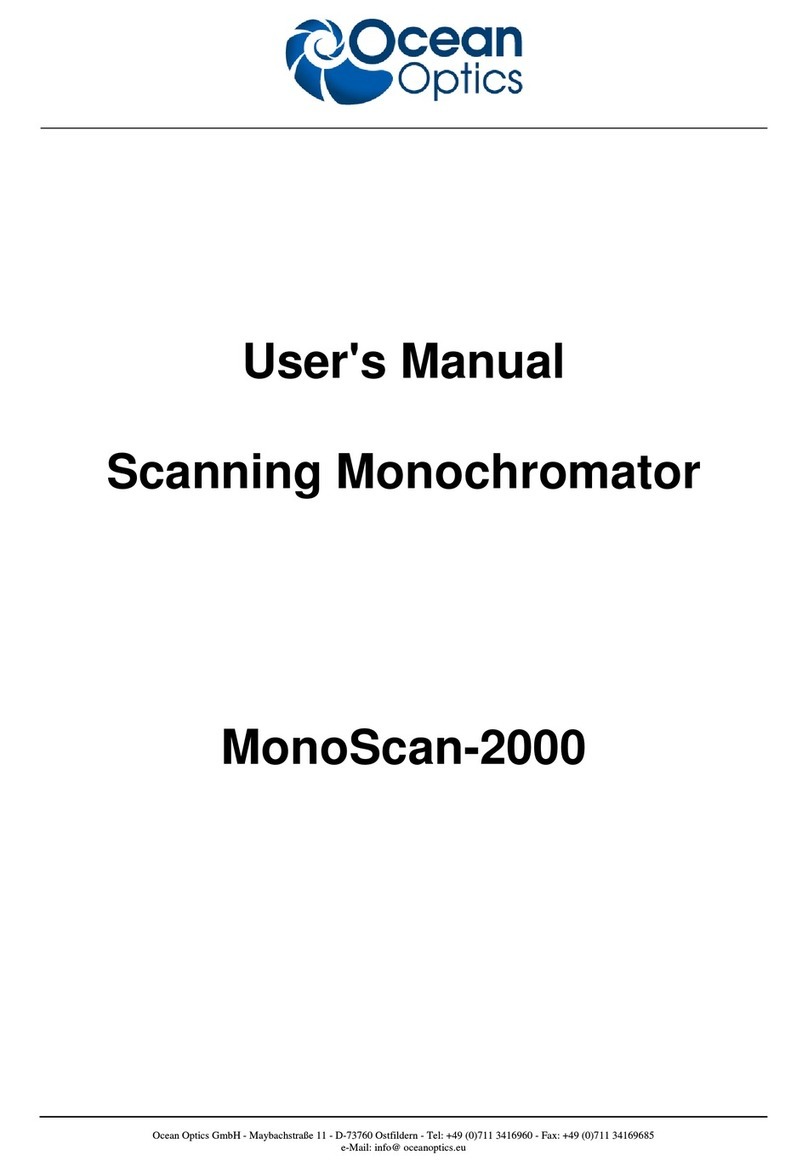
Ocean Optics
Ocean Optics MonoScan-2000 user manual
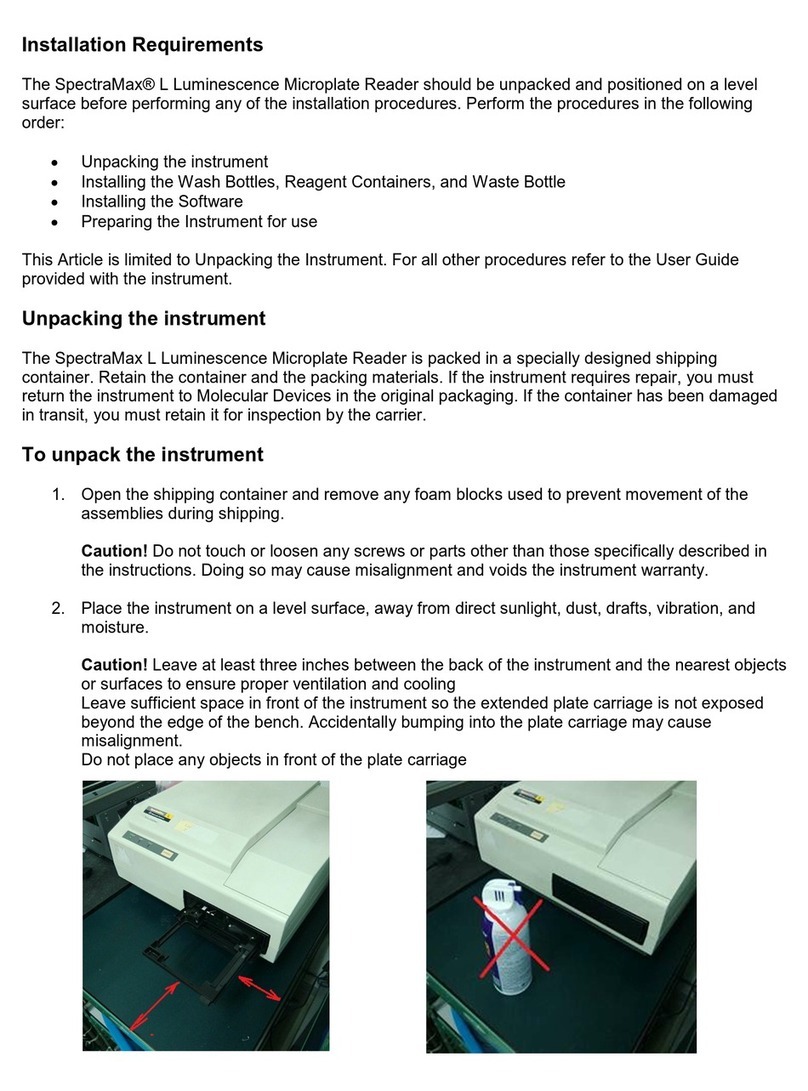
Molecular Devices
Molecular Devices SpectraMax L INSTALLATION PROCEDURE
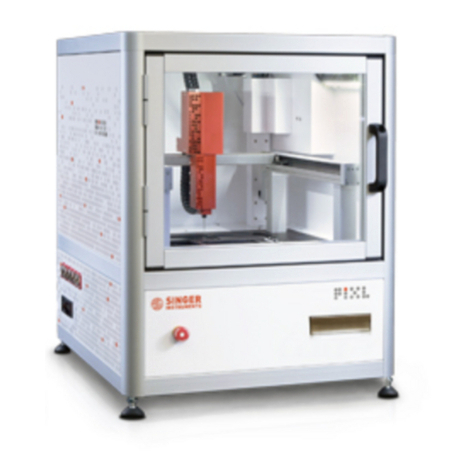
Singer Instruments
Singer Instruments PIXL LIGHT CURTAIN quick start guide

TCS
TCS 3506-01 operating instructions
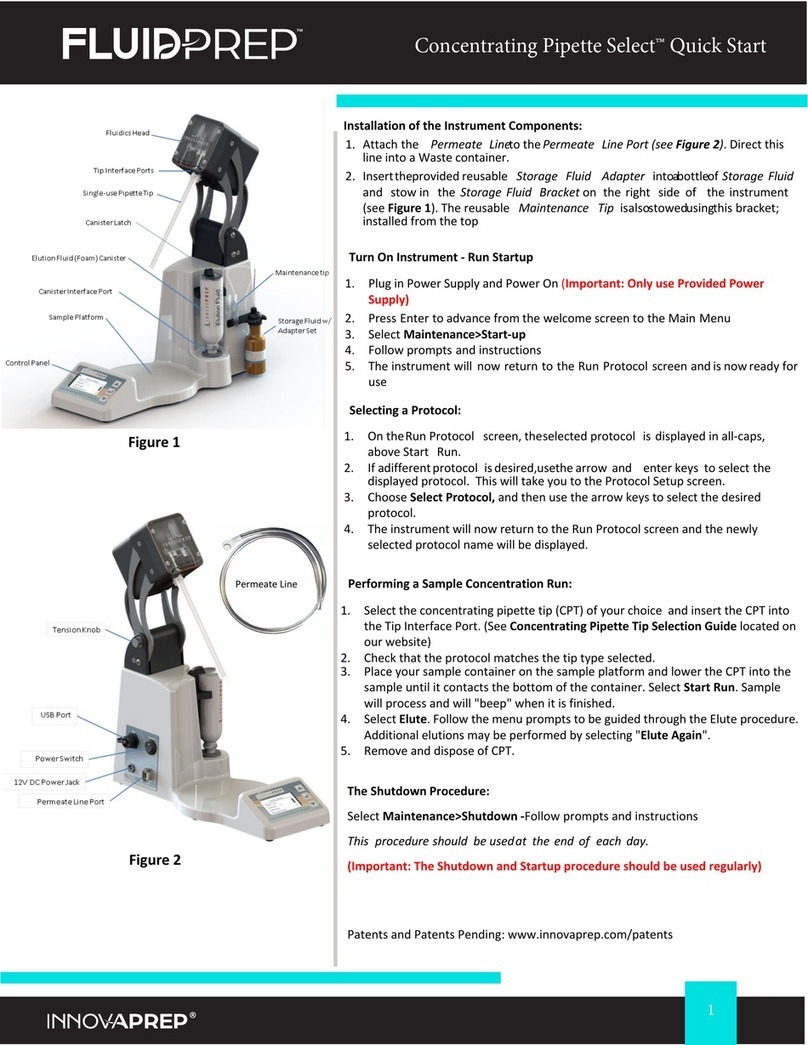
InnovaPrep
InnovaPrep FLUIDPREP Concentrating Pipette Select quick start

Stryker
Stryker RemB 6400-276-000 Instructions for use


